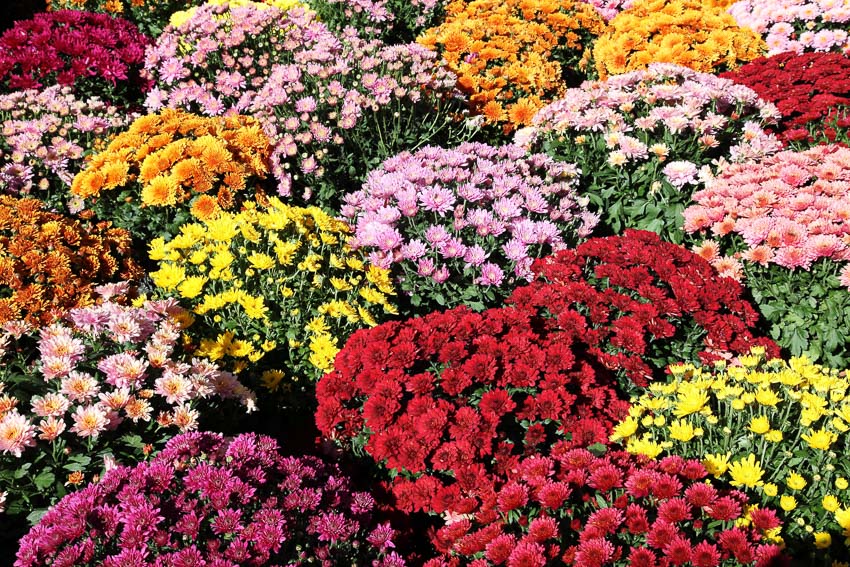Northeast winters are long and harsh, and there’s a lot to do before the snow flies. Even though it might seem like you don’t have time for everything, it pays to take a day to winterize your herb garden and prepare perennials for winter. Learn how to overwinter perennials to enjoy healthy herbs in the spring.
What is Overwintering?
Unlike annual flowers, which only live one year, perennial plants live three or more years. Many of them are hardy enough to survive the winter without help. But some need a little assistance to ensure their survival. This process is called overwintering.
Methods for overwintering perennials vary depending on several factors. These include the type of plant, your climate, and whether your perennial is in a container or field-grown.
Why Knowing How to Overwinter Perennials is Important
One of the main benefits of planting perennials is that they come back year after year. As such, you don’t have to keep purchasing new plants. However, the harsh weather conditions in the Northeastern United States present challenges for many types of perennial herbs.
Understanding Perennial Life Cycles
Perennial plants live for three or more growing seasons. While they are generally easy to care for, it helps to understand their life cycle to ensure their survival.
Dormancy Periods and Their Role
Plants that grow in harsh winter conditions go through a dormancy period during the coldest parts of the year. Dormancy in plants is a little like hibernation in animals. This is typically between November through January or February in the Northeastern US.
Natural Defenses and Their Limitations
The growth habit of woody perennial herbs like thyme and lavender protects against heavy snows flattening and smothering them. It will also create a nice mound of snow that protects the crown of the plant from severe cold.
Extremely cold winters like those experienced in the Northeast can cause parts of your perennial herbs to die back. If there isn’t enough snow cover before a severe cold snap, it can damage the plant, killing it or causing it to get a late start in the spring.
Challenges of the Northeastern Winter
Northeastern winters are famous for being cruel and harsh. The fluctuating temperatures and heavy snows contribute to less-than-ideal growing conditions for many types of plants.
Fluctuating Temperatures
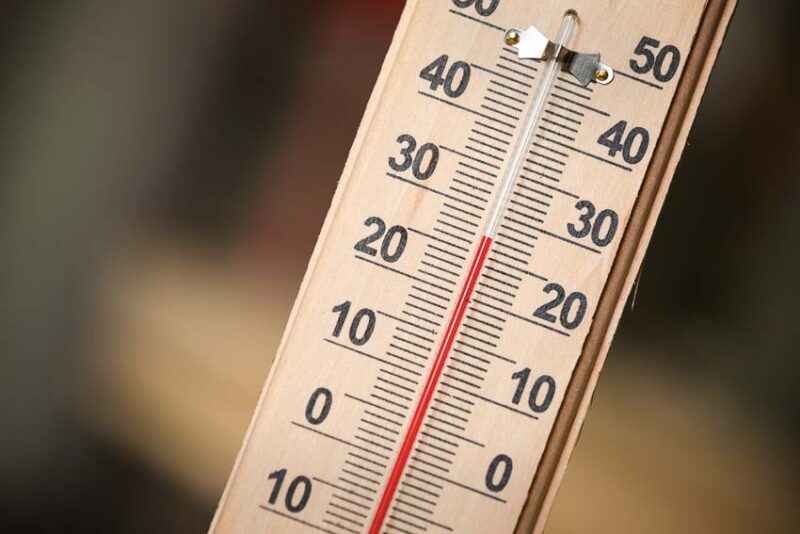
The fluctuating temperatures commonly seen during New England and the mid-Atlantic winters cause problems for different types of plants.
The freeze and thaw cycles can disrupt the root systems of plants. Sometimes, warm spells can signal to perennial plants that it’s time to start growing, and when followed by a shock of cold weather, your plants can be damaged.
Heavy Snow and Ice Concerns
Heavy snow and ice flatten perennial herbs, destroying their nicely mounded shapes and breaking branches under the crushing weight.
Protecting perennial herbs like thyme is critical to avoid winter damage. It’s even more important if you grow your perennial herbs as ornamentals.
Worried about your garden as the cold approaches? Check out our guide to preparing your garden for winter!
Benefits of Preparing Perennials to Overwinter in the Northeast
While many perennial herbs are extremely resilient, the unforgiving winters in the Northeast can take a toll on your herb garden. It’s worth spending some time in the fall to prepare your herbs for overwintering.
Enhancing Plant Health and Longevity
All types of perennial plants benefit from some kind of winterization effort, as it encourages them to live longer and grow healthier.
Reducing Stress and Damage
Perennial plants that aren’t shocked by freezing cold temperatures or smothered by ice and snow are less likely to be stressed and damaged during the winter.
It doesn’t take much time to cut back dead foliage in the fall, clean up the debris around your plants, or add a little mulch to your herbs to ensure they survive the winter without any lasting damage.
Promoting Vigorous Spring Growth
Overwintering your perennial herbs will promote vigorous growth in the spring. When their root systems are intact and healthy, it’s easier for them to start growing again once the temperatures warm up.
Overwinter Your Perennials to Save Time and Money
Overwintering techniques can help you save money on perennials, both in terms of time and money spent on purchasing plants.
Minimizing Replacement Costs
The cost of perennial herbs is significant enough to warrant spending the time in the fall to care for them to ensure their health and vitality throughout the long, cold winters in the Northeast.
Plants like rosemary and lavender can live for decades. Even though other herbs, like thyme, are best if you renew them every few years, ideally, you can keep your perennial herbs alive for many years by properly caring for them.
Reducing Spring Rehabilitation Efforts
Overwintered perennial herbs bounce back quicker and take less effort to rehabilitate in the spring. If your herbs sustain winter damage, such as broken branches or winter burn, it’s harder to get them back to full health in the spring.
By pruning dead or damaged areas in the fall, your plant can conserve energy and focus its energy on new growth in the spring. Cleaning up in the fall also makes it easier to garden in the spring because everything is already tidy.
How to Overwinter Perennials and Preserve Landscape Aesthetics
Another reason to prepare your perennial herbs for winter is that they look better. Not only will winterized perennials fare better and grow stronger in the spring, but they will also provide a superior gardening aesthetic for your landscape throughout the winter months.
Avoiding Unpleasant Winter Appearances
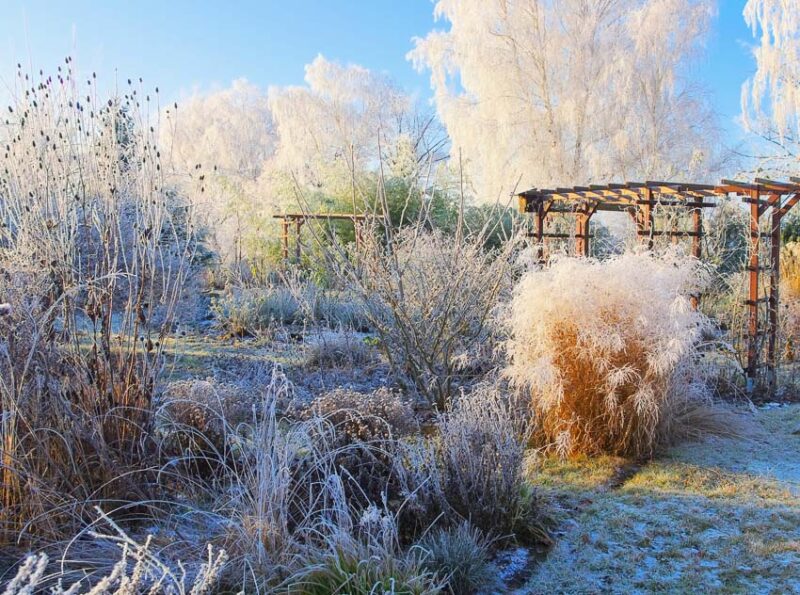
Winter gardens can be drab and unsightly. When you overwinter your perennial herbs, you will improve their appearance and enjoy a better winter garden aesthetic. A neat and tidy herb garden is visually pleasing, even in the winter, and as an added bonus, it’s less likely to attract pests and diseases.
Ensuring Consistent Blooms and Foliage
The extra care you take to winterize perennials will ensure you enjoy more consistent blooms and foliage in the next growing season.
You can’t see all winter damage to plants. You may not even know when your plant has been stressed by the harsh winter conditions that are so common in the Northeastern United States.
Get your lawn in gear before the cold arrives! Explore our Tips for Fall Lawn Care and guide to Preparing your Lawn for Winter.
Tips on How to Overwinter Perennials in the Northeast
Because of the severe weather conditions, overwintering perennials in the Northeast is a little more challenging than in other parts of the US. Here are some tips and techniques to use for overwintering perennials.
Proper Mulching Techniques
When overwintering, choosing the right mulch and applying it at the right time is critical to ensure the health and vitality of your perennial herbs.
Choosing the Right Mulch
Applying a layer of mulch around the base of your plants will help protect the roots by retaining moisture and preventing them from getting too cold. There are several types of mulch that you can use, including the following:
- Straw
- Chopped leaves
- Pine bark
- Pine needles
- Compost
- Grass clippings
Application Timing and Depth
Most herbs like well-drained soils and don’t need a lot of mulch. Applying mulch too early can disrupt the process plants use to prepare for winter. The best time to apply mulch to your herbs in the fall is right after the first frost.
Watering and Fertilizing Before Frost
Winters in the Northeast are long and cold, and your perennial herbs should head into winter fully hydrated and properly fed.
Hydrating Perennials Adequately
Once the temperatures start to drop in the fall, plants don’t need as much water, but it’s important to keep an eye on the moisture content of your soil and continue to water regularly until the ground freezes.
In the Northeast, your herb garden will be subjected to dry winds and freezing temperatures that suck the moisture out of the soil. If they start out dehydrated, they are much less likely to thrive in the spring.
Avoiding Late-Season High-Nitrogen Fertilizers
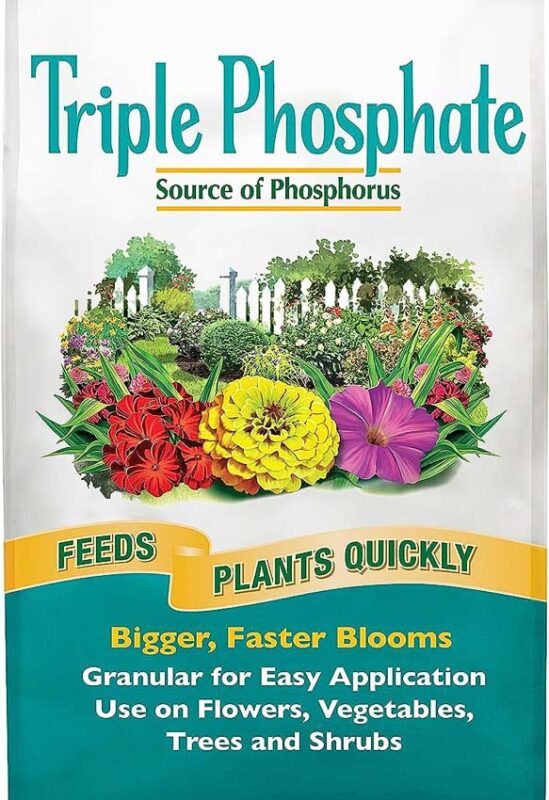
Giving your perennial herbs a nutritional boost will help them bounce back quicker in the spring, but you want to avoid high-nitrogen fertilizers. You want to avoid nitrogen because it encourages green growth, and this is the time of year when perennials are focusing on their root systems.
Part of your overwintering regimen should include fertilization. The best fertilizer for perennials in the fall is a high-phosphate fertilizer with low nitrogen content, such as Espoma TP6 Triple Phosphate Fertilizer .
Want to feed your perennials? Have a look at our guide on How to Compost!
Protective Measures for Vulnerable Perennials
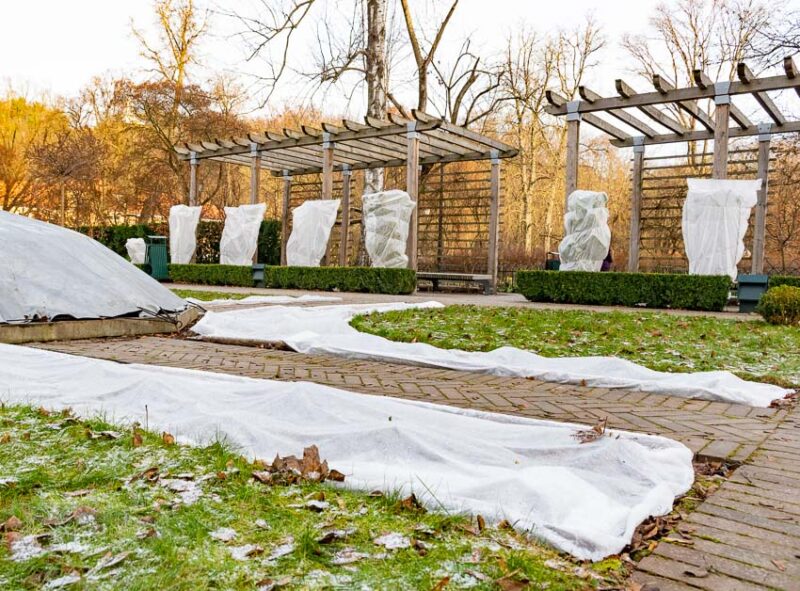
Vulnerable perennials need special care to survive the winters in the Northeast. Using burlap, protective barriers, and temporary greenhouses will ensure their survival.
Using Burlap and Other Protective Barriers
If you want to overwinter perennials in pots, use protective barriers. Plants that are overwintered in containers are more vulnerable than field-grown plants, so you must protect them with burlap, thermal blankets, or mulch. The same is true if you’re growing a plant that likes warmer temperatures than your growing zone allows.
You can use several methods for overwintering perennials in containers. If they are in one-gallon pots, lay them on their side and stack them like shingles, then lay a thermal blanket over the top. You can also pack sawdust around containers so that all parts of the container are buried, protecting the perennials from drying out and freezing during the winter.
Temporary Greenhouses and Cloches
Some plants may need to be overwintered in temporary greenhouses or cloches. These temporary structures will provide ample protection from the harsh elements and help your garden herbs from being damaged by heavy snow and ice. Overwintering perennials in raised beds with polytunnels is another effective method to use.
Pruning and Cutting Back
Your perennial herbs will be healthier in the spring if you remove dead and diseased growth in the fall. Insect infestations like to overwinter in plant debris and spread in the spring, infecting your healthy plants.
Perennial herbs conserve resources by sending most of their nutrients to their roots. Some types of herbs are herbaceous, and you can cut them back in late winter. The best time to prune woody perennials is in the spring after new growth starts to emerge.
FAQs About Overwintering Perennials in the Northeast
Can you overwinter all perennials outdoors in the Northeast?
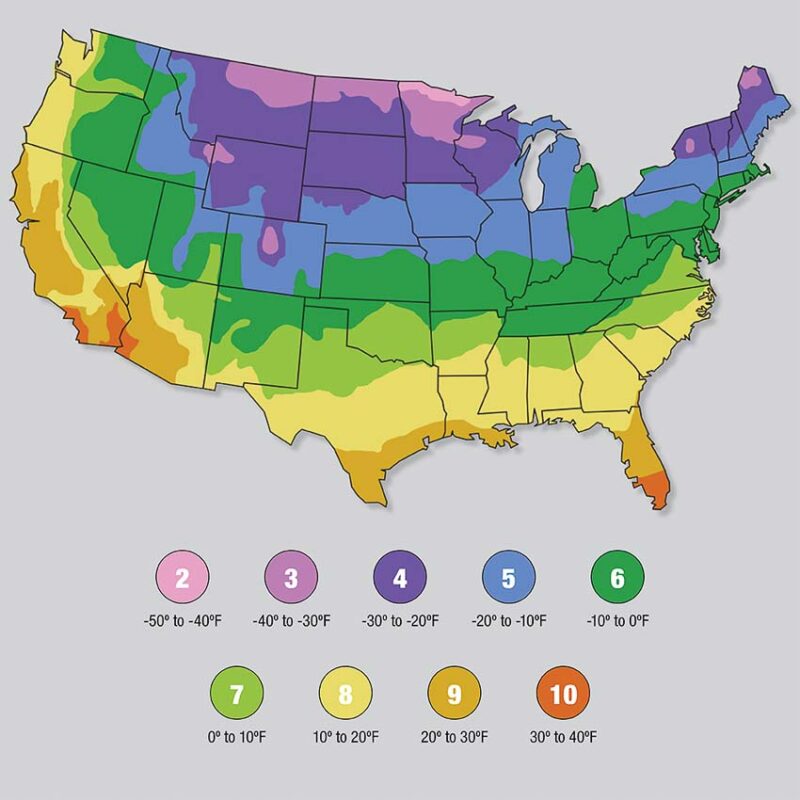
You can overwinter any perennials that will grow in your gardening zone in the Northeast. In the Northeast, your region may be in USDA hardiness zones 3 to 7, depending on where you live, so it’s important to select plants that can grow in your zone.
When’s the best time to start preparing perennials for winter?
Once the temperatures drop in the fall, you can begin to prepare perennials for winter. Stop fertilizing and slow down your watering schedule, but continue to water every two weeks until the ground freezes.
Many perennial herbs will take care of themselves and don’t need any further care. Others can be cut back to their basal foliage after a killing frost.
Do perennials require frequent watering during winter?
Perennials don’t need frequent watering during the winter, but if your region goes through a long, dry spell, you may need to water your perennial herbs during the winter to prevent root desiccation and winter burn, especially for evergreen shrub perennials like rosemary and winter savory.
For best results, only water when the air temperature is above freezing, and don’t water more than once a month.
Should I be concerned about pests when overwintering perennials?
Pests and diseases can be problematic when overwintering perennials, but many herbs naturally repel insects and rodents. However, pests like to overwinter in plant debris, mulch, and leaf litter, so you may notice signs of them overwintering in your perennial herbs.
Use general garden care practices in the fall, such as removing debris and dead annual plants, to avoid major problems with insects and pests in your herb garden during the winter.
Can perennials be divided or transplanted in the fall?
Fall is one of the best times to divide and transplant perennial herbs. Depending on the weather, you can do it during September and October. However, don’t wait too long because they need some time to establish before the really cold weather hits.

